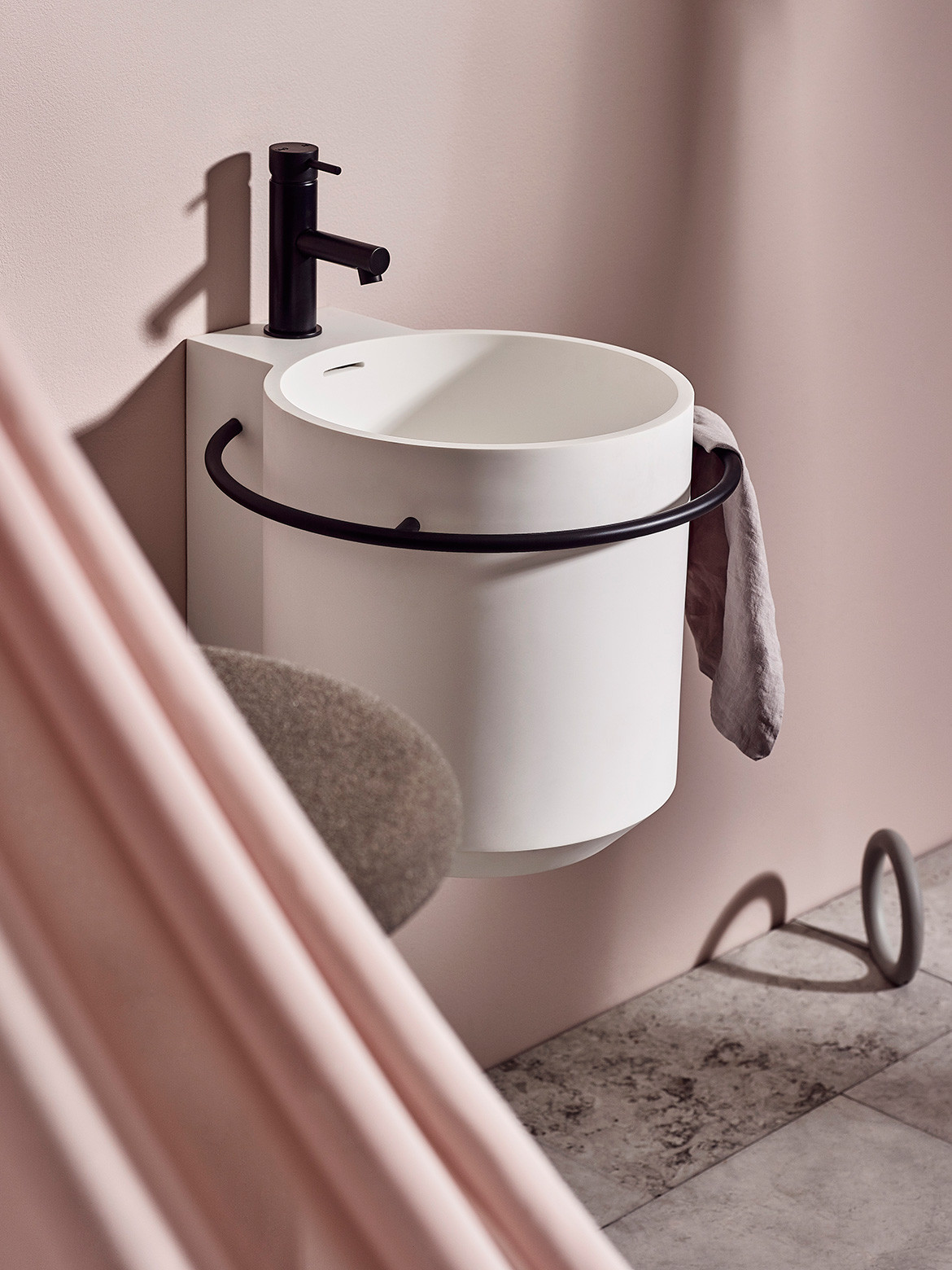A new decade has dawned and with it has come a fresh perspective and not-so-serious attitude to bathroom furniture design. Designers are taking a lighter, more playful and sometimes nostalgic approach, creating bathtubs and basins with architectural and sculptural forms inspired by traditional baths, troughs and vessels, and made all the more surprising in ethereal and energising hues. These stand-out pieces can stand alone in a bathroom, or they can be mixed and matched and customised to create an original and positively personal space.
The bathroom is a place we hit refresh in the morning and wash away the day at night. As colour can have a powerful effect on our mood and emotions, a bathroom awash with colour can energise and inspire. Designers are embracing more eclectic colour and combinations, pairing bright and surprising hues with muted colours and neutrals.

 The soft, fluid form of the Acquerello collection is enhanced with two-tone colours and a contrast of finishes.
The soft, fluid form of the Acquerello collection is enhanced with two-tone colours and a contrast of finishes.The Acquerello basin collection, designed by Prospero Rasulo for Valdama, has a two-tone colour-blocking effect to enhance the basin’s fluid form.
Acquerello (meaning ‘watercolour’ in Italian) has a soft and sensual shape with gentle, shallow curves that never cast a clear-cutshadow. The interchangeable colours allow for personalisation: the basin and tablet are available in a sulphur yellow, soft pink, ocean blue and lagoon green, along with black, white grey and clay. “The colours have been chosen and interpreted like small inventions,” says Italian artist and designer Prospero. “Each is its own distinctive colour, and a colour capable of representing the shape in the best possible way.” Prospero took inspiration from his homeland, looking to nature, light, art and sculpture, and selecting colours that work in combination and in a variety of settings and styles.

 The vanity is the hero of the Frieze collection.
The vanity is the hero of the Frieze collection.The Freize and Nouveau collections from Ex. T are also a fresh take on colour and form, with inspiration drawn from Roy Lichtenstein’s Entablatures series and the early-twentieth-century styles of art nouveau and art deco.
Frieze, designed by Marcante Testa, is a colourful collection with a strong architectural imprint. Andrea Marcante and Adelaide Testa looked to Lichtenstein’s Entablatures from the 1970s: a series of paintings comprising horizontal layers evoking the architectural façades and ornamental motifs the artist encountered around New York. Marcante Testa used the same geometry, graphics and colourways in the Frieze collection, creating a range of basins that sit against a horizontal band. The basin, intended as the central element, comes in bright turquoise, lilac and soft pink and can be embellished with graphic patterns. Bathroom accessories can be hung on the horizontal band and different wall finishes can be used above and below. The combinations of shapes, colours, finishes and materials allows for unique and original combinations and a versatile system both spatially and stylistically.
Also from Ex. T, the Nouveau bathtub designed by Paola Vella and Ellen Bernhardt is inspired by the distinctive geometries of art deco and rendered in a blush pink drawn from the colour palette of art nouveau. The small size and asymmetrical shape enable the bathtub to be positioned against the wall, in a corner or as a centrepiece of the room.
 The Halo is made of recyclable material that United Products can recondition or recast into a new basin or bath.
The Halo is made of recyclable material that United Products can recondition or recast into a new basin or bath.As the twenty-first century marches on into territories unknown, many designers are finding comfort in the familiarity of traditional forms of basins and vessels and reinterpreting them in a contemporary way.
Hargreaves Vanity is from a collaboration of Central Coast-based designers – Loughlin Furniture, Fabric Architecture and Slabshapers – and is inspired by the classic laundry trough. It has a rectangular concrete basin, VJ panelling on the cabinetry, aged brass taps and timber caddies for bathroom accessories. “It has an underlying coastal vibe that conjures up the image of summer holidays spent at a mid-century beach house,” says Brent Fitzpatrick, co-director of Fabric Architecture.
Neri&Hu also looked to a traditional vessel for its Immersion collection for Agape. Inspired by the relaxing Japanese onsen, the Immersion bathtub is smaller, deeper and more upright than a standard tub. It has a straight outer profile and a half-spherical inner profile that allows for full submersion in a more upright posture.
 Neri&Hu’s Immersion bathtub is designed for smaller bathrooms, having a deeper and more compact form than standard tubs.
Neri&Hu’s Immersion bathtub is designed for smaller bathrooms, having a deeper and more compact form than standard tubs.The compact footprint of the Immersion tub is designed for a smaller bathroom, as is Thomas Coward’s collection of bathroom products for United Products. Halo has a decorative metal ring that enables the hand towel to be part of the basin, while Lunar has a pedestal base, evocative of a baptismal bathing vessel and able to be placed against a wall or away from it to create a stand-out and standalone piece.
With eclectic colours and forms, the new generation of products enables designers and customers to create a bathroom that indulges their own personal style. To create a space that is energising and refreshing, or calm and relaxing, setting the tone at the start or end of a day.
Photography courtesy of the designers and brands
We think you might also like bathroom design in the age of Instagram

